Battle of Lower Silesia
The situation before the battle
In the course of the Vistula-Oder operation, the troops of the 1 of the Ukrainian Front on a broad front reached the River Oder and, forcing the river, captured several bridgeheads. At that, the operation was suspended, since in order to continue the offensive in the Berlin direction it was necessary to wait for the successes of the right flank of the strategic front in East Prussia and Pomerania.
At the same time, fighting continued in certain areas. So in early February, the troops of the 3rd Guards Army of Gordov and the compound of the 4th tank Lelyushenko’s armies liquidated the encircled enemy group south of Rutzen. In these battles, 13 thousand enemy soldiers and officers were eliminated, about 3 thousand people were captured. Heavy fighting continued in the area of the city of Brig, which stood on the right bank of the Oder and was turned into a powerful stronghold. The 5th Guards Army of Zhadov and the 21st Army of Gusev captured the bridgeheads south and north of the city and sought to unite them. First, they connected the bridgeheads and surrounded the city, and then took it, creating one large bridgehead, on the right bank of the Oder. The fighting in the Brig area ended only just before the start of a new operation. In addition, there were fights of a local nature, the Soviet troops expanded the bridgeheads, eliminated the remnants of the German units scattered and encircled in the rear, etc.
In the meantime, the German command, with great efforts, prepared a new defensive line, which rested on powerful fortress cities: Breslau, Glogau and Lignitz. Not being able to create several solid defense in depth lines that were on the Vistula, the German command relied on fortress cities with a double - internal and external - defensive bypass, strong points. Old fortresses, castles, barracks, railway depots, railway stations, powerful stone buildings turned into defense units, the streets were blocked by strong barricades, they dug anti-tank ditches. The barricades were occupied by separate units armed with machine guns, anti-tank rifles and faust-cartridges. All small garrisons were associated with each other communications, including underground, concreted, trying to support each other. Hitler ordered to defend the fortress to the last soldier. The Germans were a serious opponent and fought not only under the threat of a whole system of punitive measures, but also being patriots of their country. The garrisons included not only regular troops, but SS troops, various training, special units, militia battalions (volkssturm).
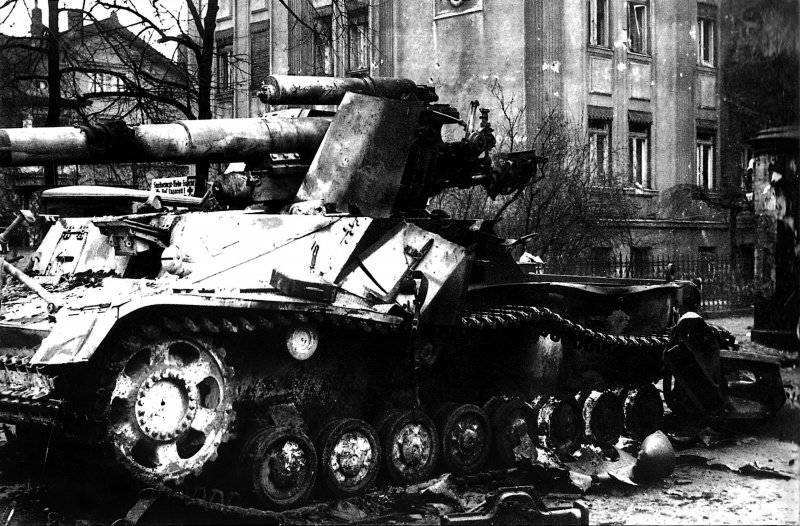
German self-propelled gun "Hummel", destroyed by Soviet troops in the Polish city of Brig
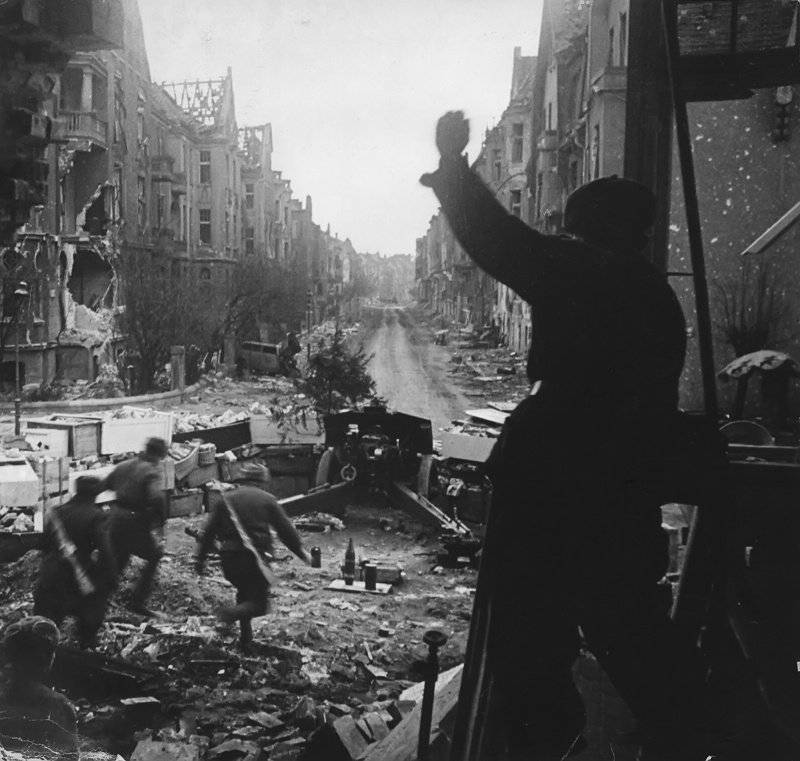
122-mm howitzer M-30 Senior Sergeant G.E. Makeeva on Gutenberg Strasse (Gutenberg) in the city of Breslau. Photo source: http://waralbum.ru/
Operation plan
The Lower Silesian operation was planned at the end of January 1945 by the command of the 1 of the Ukrainian Front as early as during the Vislo-Oder operation. The Supreme Headquarters approved the submitted plan. According to the original plan, the operation was to be carried out to a considerable depth. However, the course of the operation made its adjustments, and the plan was changed in the course of the attack.
The Soviet command hoped, while the enemy had not stabilized the front, to continue the offensive and move as close as possible to Berlin. They planned to strike the main blow with two bridgeheads on the Oder - north and south of the city of Breslau. At the first stage of the operation, the troops of the front had to take or besiege Breslau, and at the second stage - to overcome the border of the Neisse River and develop an offensive in the Berlin direction. In addition, the troops of the left wing of the 1 of the Ukrainian Front were to develop an offensive on the Dresden axis, defeating the enemy in cooperation with the 4 of the Ukrainian Front.
The troops of the 1 of the Ukrainian Front attacked in three directions. The first most powerful strike force coming from the bridgehead northwest of Breslau (3-I Guards, 13-I, 52-I and 6-I, 4-I tank, 3-I Guards Tank Army, 25-I tank, 7- th Guards Mechanized Corps), was supposed to strike in the general direction of Cottbus. At the same time, part of the grouping was to take part in the encirclement and capture of Breslau. The second group, advancing from the bridgehead south-east of Bruslau (5-I Guards and 21-I armies, 31-i tank, 4-i Guards tank corps), struck in the general direction on Görlitz. The forces of the front left wing (59 and 60 army, 1 Guards Corps) attacked from the bridgehead north of Ratibor along the northern slopes of the Sudeten Mountains to advance the main attack forces of the front. Later, part of the forces of the left wing were transferred to the right flank of the front (1-th Guards Corps).
The forces of the parties
The 1 of the Ukrainian Front consisted of: 3-I Guards Army Vasily Gordov, 13-I Army Nikolai Pukhov, 52-I Army Konstantin Koroteev, 6-I Army Vladimir Gluzdovsky, 4-I Tank Army Dmitry Lelyushenko, 3-I Army, Dmitry NN, 5-I, 21 Tank Army, Dmitriy Llyushenko's 59 Army, 60 Tank Army, Konstantin Koroteev Pavel Rybalko's tank army, 25-I Guards Army of Alexei Zhadov, 31-I army of Dmitry Gusev, 4-I army of Ivan Korovnikov and 7-I army of Pavel Kurochkin. In addition, the front had 1 and 2 tank corps, 980 Guards tank corps, 1300 Guards mechanized corps and 2400 Guards cavalry corps. The air forces of the front were supported by the XNUMX-I air army of Stepan Krasovsky. Total: about XNUMX thousand people, about XNUMX tanks and SAU, about XNUMX aircraft.
The Soviet troops were opposed by the 4 tank army, the 17 army, the Heinrici army group (part of the 1 tank army) from the Army Group Center. From the air, the German troops supported the 4 air fleet. In total, the German grouping consisted of 25 divisions (including 4 tank and 2 motorized), 7 combat groups, 1 tank brigade, corps group "Breslau". Already in the course of the battle, the German command transferred several more divisions to counteract the advancing Soviet forces. In addition, there was a significant number of separate, special, training units and subunits, the militia battalions.
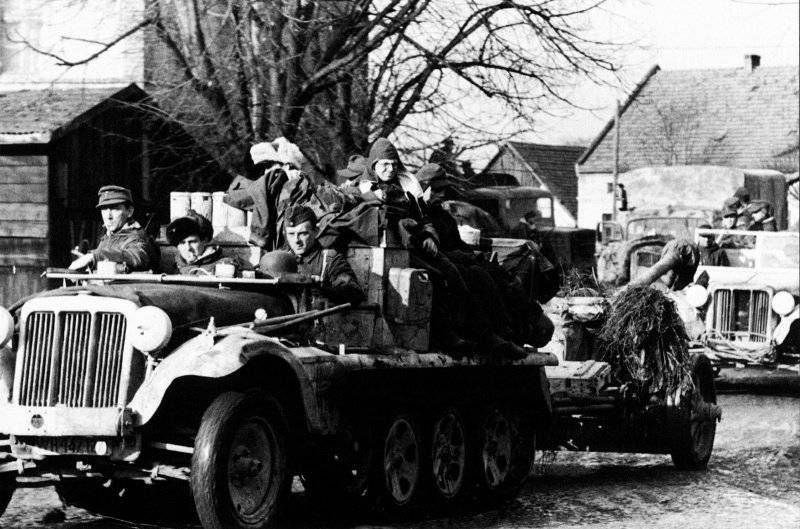
Column on the march during the retreat of German troops from Breslau. Ahead, the Sd.Kfz 10 tractor tows an 75-mm PaK 40 anti-tank gun
Battle
The first stage of the operation. The offensive began at 6 on the morning of February 8 of the year 1945 after fifty minutes of artillery preparation. In order to increase the strike force of the combined-arms armies from the very beginning and achieve a decisive victory in the very first days of the battle, both such armies had to attack in the first echelon. Exhausted by long battles and to a large extent bloodless infantry divisions, it was necessary to reinforce them with tanks in order not to be bogged down in the German defense. In two directions of the main attack, superiority in forces was created: in the infantry in 2: 1, in artillery - in 5: 1, in tanks - 4,5: 1.
Despite the lack of ammunition, which did not allow for a longer artillery preparation and bad weather, which interfered with work aviation, on the first day, Soviet troops broke through the enemy’s defenses. In the direction of the main strike, a gap was created with a width of up to 80 km and a depth of 30-60 km. However, further the pace of attack fell sharply. In the following week, until February 15, armies of the right wing of the front managed to pass only 60-100 km with combat. The Germans stubbornly resisted. Soviet divisions were tired. The average daily rate of infantry advance was now only 8-12 km, and it was simply impossible to demand more. In addition, spring thaw also slowed the pace of offensive. The terrain was wooded, in some places swampy, it was possible to advance mainly only along the roads.
Soviet troops reached the Bober River, on which the Germans had a rear line of defense and, forcing the river on a number of sectors, began fighting for the expansion of bridgeheads. Tankmen Lelyushenko broke further, across the river Kweis and came to Neisse. However, parts of the 13 Army of Pukhov did not keep up with the tank crews. German troops were able to close the gap for the 4-th tank army, and for several days it was cut off from the infantry, which was mired in the German defense. Konev had to leave the location of the army Pukhov. The counter defense of the 13 Army and the 4 Panzer Army, which turned back, broke through the German defense. Aviation played a major role in the success of the operation. The weather improved these days and the Soviet Air Force struck powerful blows at the enemy.
At the same time, 3-I Guards Army of Gordov, part of the forces blocking a significant enemy grouping in the fortress of Glogau (about 18 thousand sodat), by February 15 also reached the Bober River. The powerful fortress of Glogau was taken only on April 1-2. Thus, despite some surprises, the right wing of the front continued to advance successfully.
In the center and on the left flank the situation was more complicated. The stubborn resistance of the German troops in the area of the Breslau fortified area was delayed by the further advance to the west of the troops of the second strike group of the front - part of the 5 Guards and 21 armies. Yes, and 6-I army of General Gluzdovskogo, advancing directly on Breslau, which first successfully broke through the defenses of the enemy, then sprayed the forces and stuck. On the left flank the offensive did not lead to success. The left-flank 59-I and 60-I armies, against which German forces were approximately equal in strength, failed to break through the enemy’s defenses and February Konev ordered them to go on the defensive. This complicated the position of the center's armies, which had to look at the position on the left wing.
The German command, in order to prevent the threat of encircling the city, strengthened the Breslav grouping. First, separate parts and marching replenishments were transferred here. Then the 19 and 8 tank and 254 infantry divisions were transferred from other areas. The Germans continuously went to counterattacks. For example, the 6 Army of Gluzdovsky repelled twelve attacks in just one day. The 5 of the Zhadov Guards Army was also difficult. The army fought hard, fighting off fierce counterattacks of the enemy, and continuing the offensive, breaking down enemy barriers along the roads and storming the strongholds into which the settlements were turned. To strengthen the strike power of the army, Konev gave it 3-th guards division of heavy rocket launchers from the front reserve.
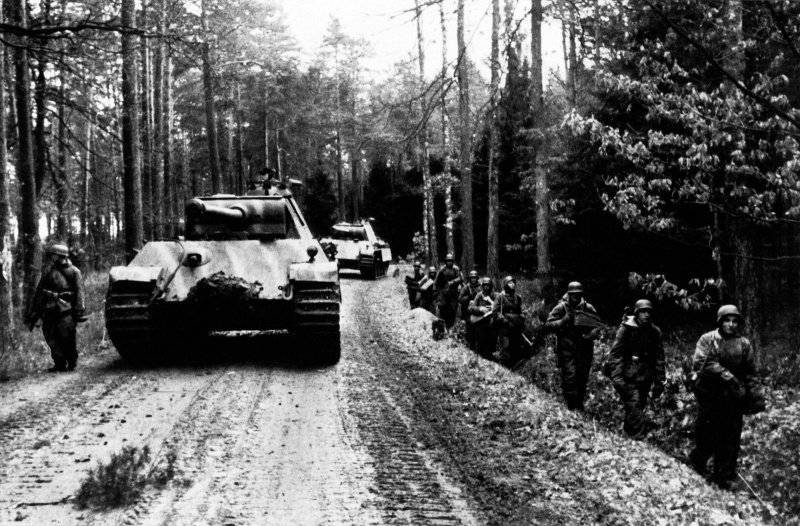
Panzergrenadery and Panther tanks on the march in Lower Silesia
The Soviet command, in order to intensify the offensive of the front, tried to solve the problem of Breslau. It was necessary to take the city, or at least surround it, freeing troops to advance to the west. To this end, Konev sprained the front of the 52 Army of Koroteyev, in order to strengthen the blow of the 6 Army and reinforced the 5 Army guards with the 31 tank tank corps. And in order that the enemy could not unblock the garrison of Breslau from the outside, the commander deployed the 3 th Guards Tank Army Rybalko in the direction of Breslau. The two Guards Tank Corps, which reached Bunzlau at that time, were sent to assist the troops of the 5 Guards and 6 Armies.
February 13 mobile units of combined arms armies joined west of Breslau, surrounding a large 80-thousand. German grouping. It was a big win. At the same time, Rybalko army tank corps west of Breslau delivered a powerful blow directly to the flank of the enemy's 19 Panzer Division. This deprived the German command of the ability to immediately throw troops at the breakthrough of the ring of encirclement, while it was not yet stabilized.
Almost immediately, a dense ring of the environment was created, which disrupted attempts to break through some surrounded parts and unlock the “boiler” from the outside. Konev decided not to bind troops by assault the fortress, leaving the 6 army to besiege the city, which did not exceed the German garrison of Breslau in number. The city, whose garrison relied on a powerful defense, capitulated only at the very end of the war - 6 in May 1945. The 5-I Guards Army was withdrawn from the battles for Breslau and strengthened the outer front of the encirclement ring.
Thus, despite some flaws, the first stage of the Lower-Silesian operation ended in complete success. From 8 to 15, February, the troops of the right wing and the center of the front broke through the enemy defenses, advanced westward to 110 km, reached the Beaver River and captured the bridgeheads on the west bank. Soviet troops captured a number of important administrative and industrial centers of Lower Silesia, including Bunzlau, Lignitz, Zorau, and others. The enemy groupings in the fortresses of Glogau and Breslau were completely surrounded and doomed to defeat. Especially the large garrison was in Breslau - 80 thousand soldiers. The fortresses were perfectly prepared for all-round defense and intra-city combat, taking into account the battle for Stalingrad, so the Soviet command did not waste forces on the assault, confining itself to a blockade and the gradual destruction of enemy positions. 4-I German tank army was defeated, all that was left of it, ran for the rivers Beaver and Neisse.
These were impressive results. However, they were reached at the maximum of the physical and moral efforts of the commanders and soldiers of the 1 of the Ukrainian Front. The divisions left an average of 4,5 thousand people, mobile connections lost up to half of the fleet (not only because of losses in battles, but also for technical reasons, the equipment life was developed, but there were no spare parts). Railways did not have time to recover. The lead over advanced supply bases has increased further. The rate of ammunition and fuel in the units dropped to a “hungry” minimum. Aviation also could not act in full force. Weather conditions were still difficult. The spring thaw caused field airfields to become unusable, the concrete strips almost all remained far in the rear. Airplanes had to act at the limit of their flight capabilities. The average air army 2 (more than 2 thousand vehicles) made about 500-550 airplanes approximately with a duck, which, with a front width of 520 km, made it possible to provide, in fact, only reconnaissance functions. During the entire operation, there were only 4 flight days.
At the same time, the neighboring fronts could not support the offensive of the 1 of the Ukrainian Front. The 4-th Ukrainian front was still unsuccessful, and the 1-th Belarusian Front fought stubbornly in Pomerania, and at the junction with the troops, Konev turned to defense. As a result, the German command was able to take measures to stabilize the front in the Silesian sector. Troops from calmer sections of the front and reserves were deployed to the onslaught of the 1 of the Ukrainian Front. Gradually, the balance of power began to change in favor of the German grouping. Soviet troops still had the advantage, but not so obvious.
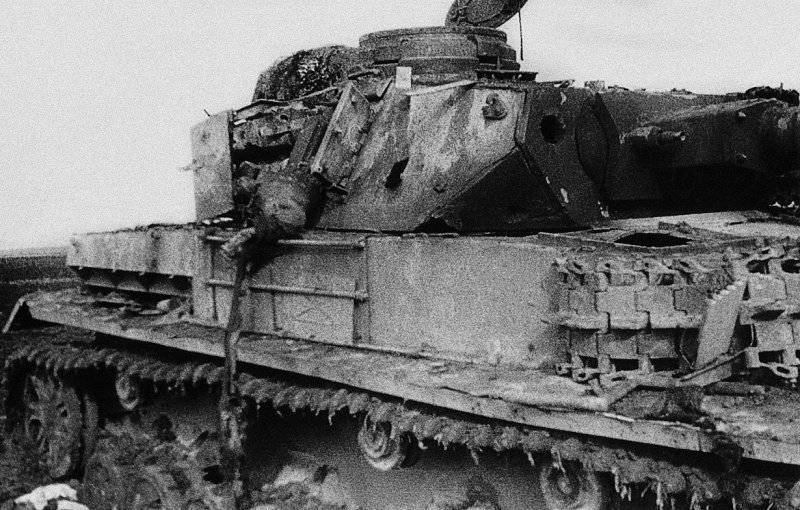
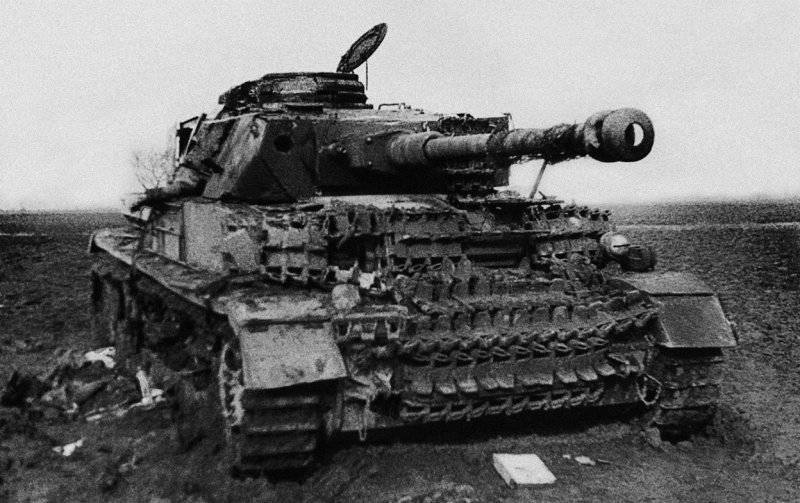
The destroyed and completely burned-out medium tank Pz.Kpfw.IV Ausf.H of late release in the battles of Breslau.
2 phase of the operation. The front command came to the conclusion that an attack on Berlin in these conditions was impossible and would lead to senseless losses, and by February 16 corrected the plan of the operation. Bid has approved a new plan. The main shock grouping of the front was to reach the Neisse River and capture the bridgeheads on the west bank; 6 Army I - take Breslau; left flank of the front - to drop the enemy in the Sudeten Mountains. In the same period, it was planned to restore the railways, to tighten the supply bases, to bring backs to a normal state, etc.
Meanwhile, on the right flank of the front there were heavy battles in the cities of Guben, Hristianstadt, Zagan, Zorau, where the enemy had a number of important military factories, including underground ones. 4-I tank army Lelushenko went to the river Neisse. It was followed by units of the 3 th Guards Army of Gordov and the 52 th Koroteev Army. This forced the German command to finally abandon the crumbling line of defense on the Beaver River and occupy a new line of defense from the mouth of the Neisse River to the city of Pentsig. Attempts of the Soviet troops to go to force Neisse and seize the bridgeheads failed.
As a result, the front command refused to try to force the river on the move. The troops of the right wing of the front were ordered to go on the defensive. Small occupied on the western bank of the riverhead were evacuated. The command of the front put in reserve the front for the replenishment and putting in order the tank army of Lelyushenko.
Meanwhile, the 3-I Guards Tank Army Rybalko was returning to the Bunzlau area. Along the way, one of the corps joined the battle with the German 8 armored division. Rybalko, having the task of reaching the Neisse and seizing the Goerlitz, decided to carry out a bold double coverage of the entire Goerlitz enemy grouping with two army corps. This was not the best solution. 6-th Guards Tank Corps already led unsuccessful battles in this direction and was exhausted, losing strike power. And the 7 Guards Tank Corps received the task of forcing the River Kweis and taking the city of Lauban, entering Görlitz from the south.
At this time, the German command organized a counter-attack in the region of Laubana. The advanced parts of the 7 tank corps entered the battle with the enemy’s tank reserves right on the march. The Germans deployed units of the 8-th tank, 10-th motorized and 408-th infantry divisions here. As a result, German troops reached the rear and flank of our 7 and partly 6 Guards tank corps and attempted to reach Rybalko’s army from the east. The fights were very hard. Only by regrouping the forces of the three corps and having received the support of the 52 Army of Koroteev, did Rybalko manage to defeat the attacking group of the enemy by February 22 and throw it to the south. The dangerous plan of the German command was destroyed. However, the army Rybalko could not complete the task - to take Goerlitz.
In the following days, stubborn oncoming battles continued in the Goerlitz and Lauban directions. As Konev recalled: "Some settlements, heights and lines several times passed from hand to hand." Although significant changes in the course of this operation in this area has not happened. Soon Rybalko’s army was also taken to the reserve of the front for replenishment. The teams left only 15-20 tanks. This operation was completed.
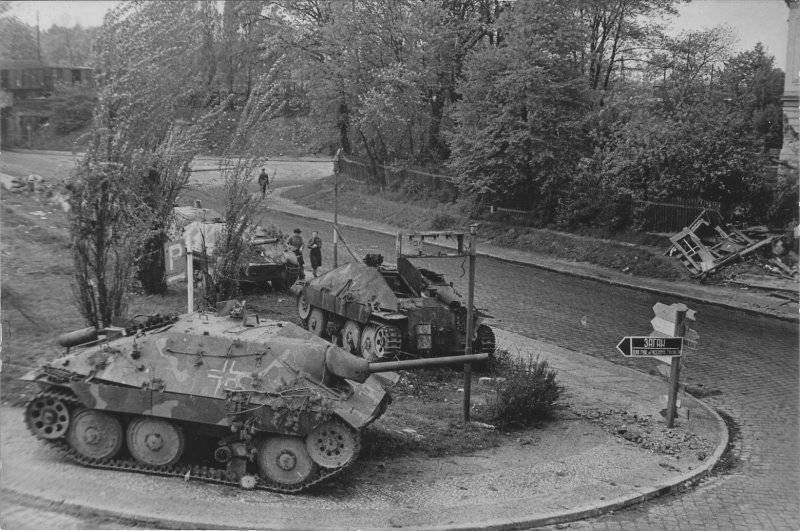
German tank destroyers Jagdpanzer 38 (t) abandoned during retreat in Silesia
Results of the operation
As a result of the Nizhne-Silesian operation, Soviet troops broke through the enemy defenses on the Oder River, Bober and Kweis, advanced into the territory of Germany by 150 km and reached the Neisse River on a wide area. Lower Silesia was occupied - one of the most important military-industrial regions of the German Empire. Entering Neis on the level of the positions of the 1 of the Belorussian Front was of great operational and strategic importance, since now the troops of the two largest Soviet fronts took convenient positions for a rush to Berlin.
In addition, with their left wing, the troops of the 1 of the Ukrainian Front loomed over the Upper Silesian group of the enemy and began to prepare for its destruction. Now it is possible to attack the enemy in the Dresden direction and liberate the central regions of Czechoslovakia.
The Lower Silesian operation had an impact on the course of military operations in other strategic areas. The troops of the 1 of the Ukrainian Front were delayed by the enemy forces and assisted the troops of the 1 and the 2 of the Belorussian fronts in defeating the Eastern Pomeranian enemy grouping and the troops of the 2 and 3 of the Ukrainian fronts in eliminating the threat of a Wehrmacht breakthrough to the Danube.
4 was defeated by the German Tank Army, and enemy garrisons were surrounded in Glogau and Breslau. The losses of the German troops are unknown, but they were significant. In addition, about 100 thousand German soldiers and officers, an entire army, were blocked in Glogau and Breslau. The total losses of the Soviet troops amounted to about 100 thousand people (of which irrevocably 23 577).
Due to a number of reasons, the front had to abandon the original plan of the operation, adjusting the tasks of the front. As Konev noted, among the reasons why the front could not accomplish the tasks assigned entirely, one should single out three. First, for a powerful strike, an operational pause and corresponding preparation were required. The front troops without a break after the first strategic operation (Vistula-Oder) immediately started the second. As a result, the 44 troops of the day (from January 12 to February 24 1945) continuously fought and attacked, passing from 500 to 700 km. The soldiers were tired, the divisions needed to be replenished with manpower (in the divisions there were 5 thousand people) and equipment. Communications were greatly stretched, the railways did not have time to restore. By February 8, the nearest supply stations were removed from the first-echelon divisions of 500 km. This led to a shortage of ammunition, fuel and other supplies and materials needed by troops.
Secondly, when the operation was planned, it was considered that the further attack of the 1 of the Ukrainian Front on the West would take place simultaneously with the continuing attack of the troops of the 1 of the Belarusian Front on the right flank and of the 4 of the Ukrainian Front on the left flank. However, the 1 Belorussian Front had to solve the threat of Pomerania and temporarily refused to attack on Berlin. On the left flank of the 4, the Ukrainian front fought hard in Czechoslovakia and almost did not advance. The lack of serious progress among neighbors has had its influence on the operation of the 1 of the Ukrainian Front.
Third, the Soviet command underestimated the enemy. The German command, using rear reserves, quickly enough managed to restore the combat capability of the units defeated on the Vistula and Oder and create a new strong line of defense. The Germans did it rather quickly and decisively. Despite the closeness of the defeat, the German military machine remained a serious opponent, which could not be underestimated.
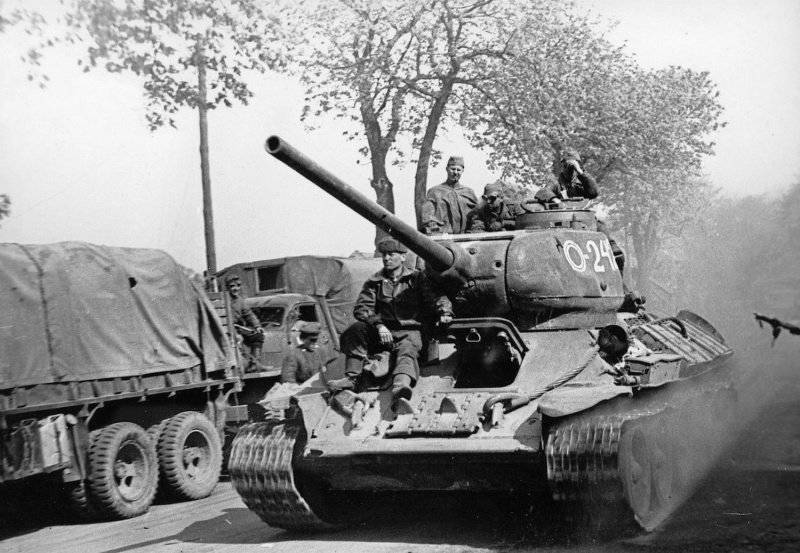
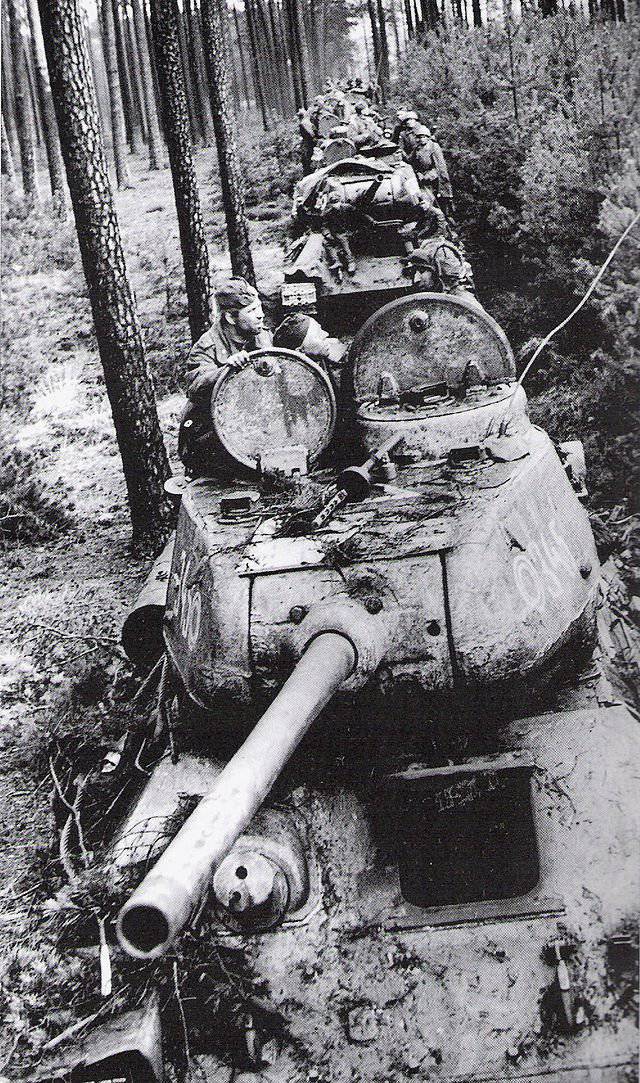
Troops of the 3 Guards Tank Army in Germany
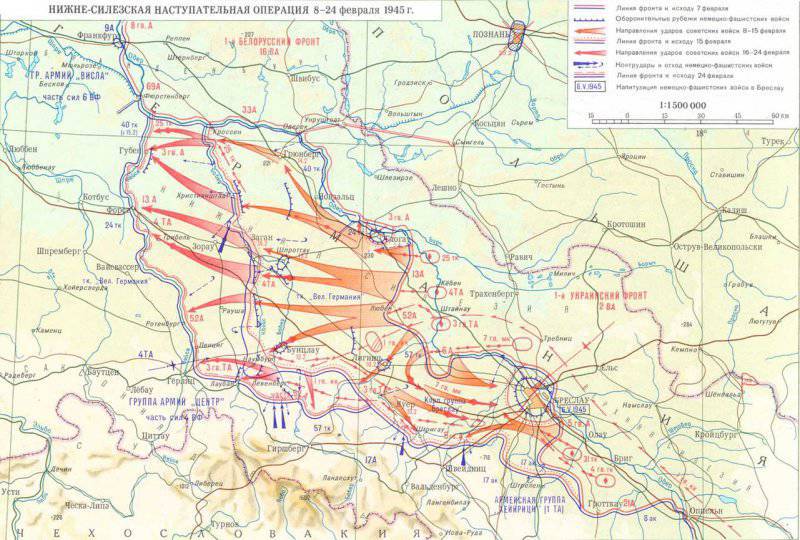
Information